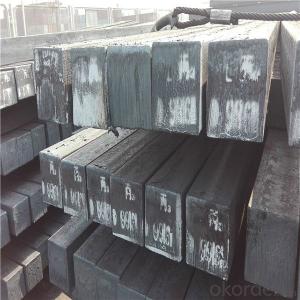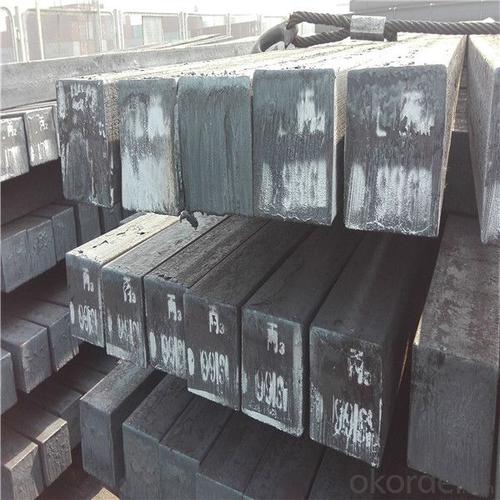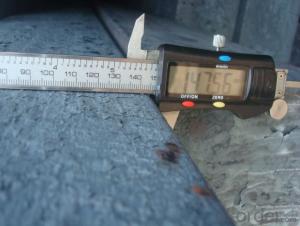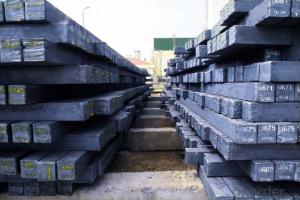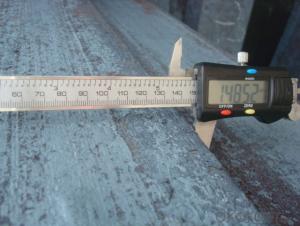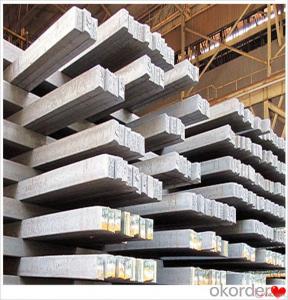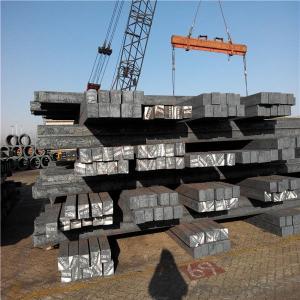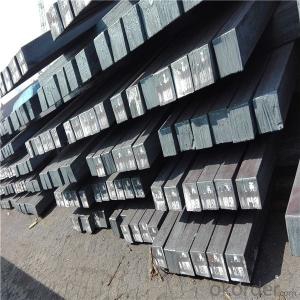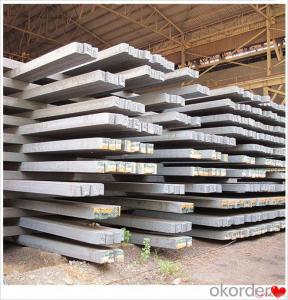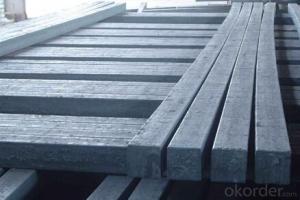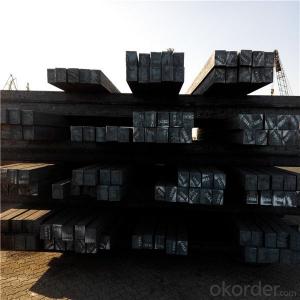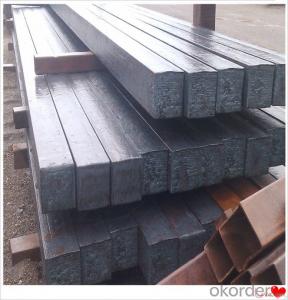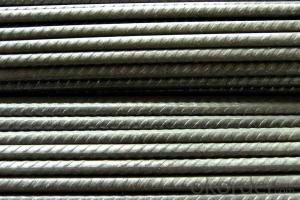Mild steel billet in China Q215/Q195/Q235/Q275
- Loading Port:
- Guangzhou
- Payment Terms:
- TT OR LC
- Min Order Qty:
- 1000 m.t.
- Supply Capability:
- 24531 m.t./month
OKorder Service Pledge
OKorder Financial Service
You Might Also Like
Specification
Steel billet
Steel billets have distinct characteristics as compared with already furnished steel bars and products. Billets
have a specific grain structure, which enables the metal to be processed more intricately. Steel billets are also
known for their malleability and ductility, especially when exposed to varying temperatures during shaping and molding.
Billet: equal cross section width and height, or a huge difference, mainly used for rolling steel, wire rod. ,
Tolerance: Strictly according to the G/B and JIS standard
Delivery time: within 45 days after receiving the L/C or advanced T/T payment.
Payment terms: 100%Irrevercable L/C at sight or T/T
Gade:
Standard | C(%) | Mn(%) | S(%) | P(%) | Si(%) |
Q195 | ≤0.12 | ≤0.50 | ≤0.040 | ≤0.035 | ≤0.30 |
Q235 | ≤0.20 | ≤1.40 | ≤0.045 | ≤0.045 | ≤0.35 |
Q275 | ≤0.22 | ≤1.50 | ≤0.045 | ≤0.045 | ≤0.35 |
20MnSi | 0.17-0.25 | 1.2-1.6 | ≤ 0.050 | ≤ 0.050 | 0.40-0.80 |
3SP | 0.14-0.22 | 0.40-0.85 | ≤ 0.050 | ≤ 0.040 | 0.05-0.15 |
5SP | 0.28-0.37 | 0.50-1.00 | ≤ 0.050 | ≤ 0.040 | 0.15-0.30 |
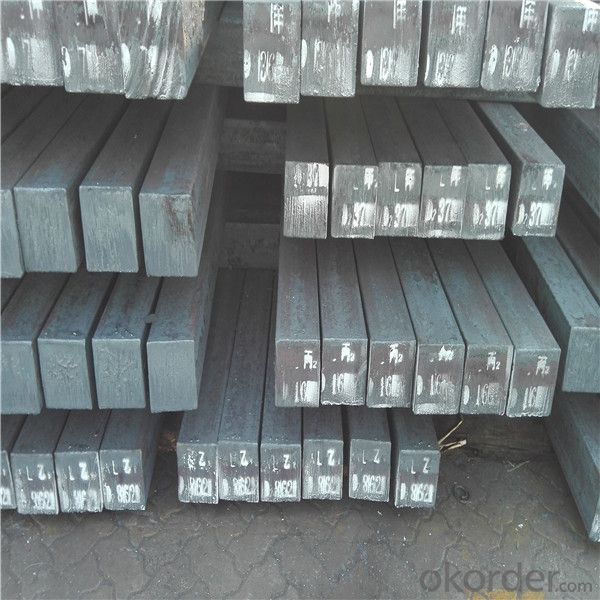
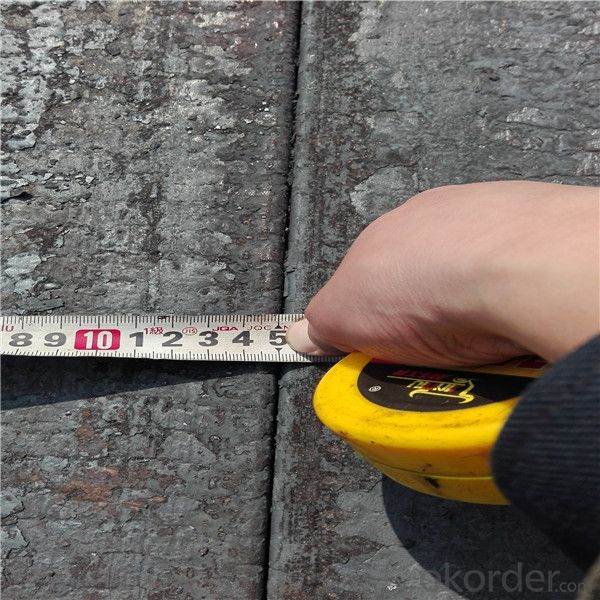
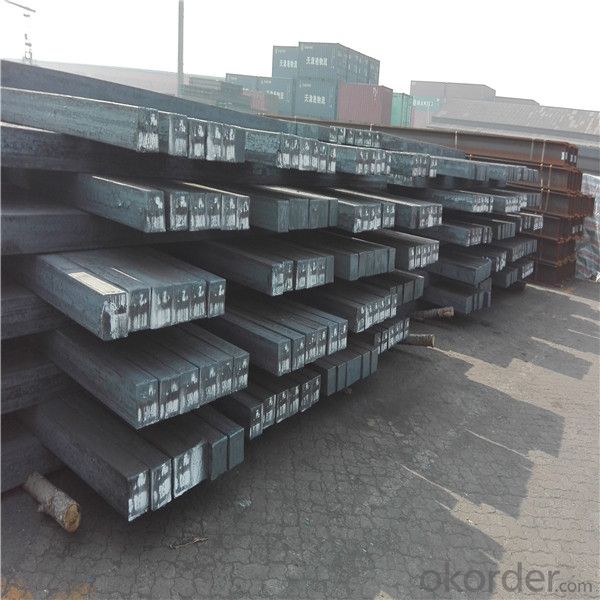
Our service :
We have a plant and professional team to provide our best service, from the start of production until the
loading into the vessel, we have a complete quality follow up procedure, to assure our products arrives to the customer with satisfaction. Welcome new and old customers
to contact us for future business relationships! We will give you a surpise price.
Packing :
Within 30 days
1.Standard export package
2.In bundles with steel strips
3.As the requirements of the customers
FAQ:
Q: What is payment terms?
A: FOB 30% T/T IN ADVANCE AS DEPOSIT AND 70% T/T BEFORE SHIPMENT
CIF and CFR 30% T/T IN ADVANCE AS DEPOSIT AND 70% T/T AS THE COPY OF B/L OR L/C AT SIGHT
Q:How to guarantee the quality of the products?
A:We have established the international advanced quality management system,every link from raw material
to final product we have strict quality test;We resolutely put an end to unqualified products flowing into the market.
At the same time, we will provide necessary follow-up service assurance.
Q:How long can we receive the product after purchase?
A :In the purchase of product within three working days, We will arrange the factory delivery as soon as possible.
The pecific time of receiving is related to the state and position of customers.
- Q: How are steel billets used in the manufacturing of slabs?
- Steel billets are an essential raw material used in the manufacturing of slabs. Slabs are large, flat pieces of steel that are used as a primary input in various industries, such as construction, automotive, and manufacturing. To produce slabs, the first step involves obtaining steel billets. These billets are semi-finished steel products that are typically obtained through the continuous casting process or by hot-rolling ingots. They are solid, rectangular or square-shaped blocks of steel with a cross-sectional area that can vary depending on the desired size and thickness of the slabs. Once the steel billets are obtained, they are heated to a high temperature to make them more malleable and easier to shape. This process, known as hot rolling, involves passing the billets through a series of rolling mills to progressively reduce their thickness and increase their length. The rolling mills apply intense pressure to the billets, causing them to elongate and acquire the desired dimensions. During the hot rolling process, the steel billets are often subjected to various manipulations, such as reheating and cooling, to ensure proper shaping and metallurgical properties. The billets may also go through additional processes, such as descaling (removing the oxide layer) and surface treatment, to enhance their quality and finish. Once the hot rolling process is completed, the steel billets are transformed into slabs. These slabs are then further processed to meet specific requirements. For instance, they may undergo additional rolling or reheating processes to achieve the desired thickness, dimensions, and surface finish. The slabs can also be cut into smaller pieces or further processed into different steel products, such as plates, sheets, or coils, depending on the intended use. In summary, steel billets play a crucial role in the manufacturing of slabs. They serve as the starting point for the production process, undergoing hot rolling and other treatments to transform them into the desired shape, size, and quality. The resulting slabs are then used as a primary input in various industries, contributing to the production of a wide range of steel products.
- Q: What are the environmental impacts of steel billet production?
- Steel billet production, being a process that yields semi-finished steel products, can have diverse consequences on the environment. One notable impact is the release of greenhouse gases during the manufacturing of steel. This occurs when iron ore is melted, emitting carbon dioxide (CO2) into the atmosphere. CO2 is a significant contributor to global warming and climate change. Another environmental effect of steel billet production is the consumption of natural resources. The steel industry requires substantial amounts of water and energy to manufacture billets. The extraction and processing of raw materials like iron ore and coal can also cause the destruction of habitats and disruption of ecosystems. Moreover, the production of steel billets can lead to pollution of both air and water. Burning fossil fuels during the manufacturing process releases various pollutants, including sulfur dioxide (SO2) and nitrogen oxides (NOx), which contribute to acid rain and respiratory issues. Additionally, the discharge of wastewater from steel production can contain heavy metals and other contaminants, polluting rivers and harming aquatic life. Steel billet production also generates solid waste, such as slag and dust, which present waste management challenges. These waste materials may contain toxic substances, necessitating proper handling and disposal to prevent environmental contamination. Several measures can be taken to alleviate the environmental impacts of steel billet production. The adoption of cleaner technologies, such as energy-efficient furnaces and recycling processes, can help reduce energy consumption and emissions. Implementing rigorous environmental management systems and investing in pollution control technologies can also minimize air and water pollution. Additionally, promoting the use of recycled steel and sustainable sourcing of raw materials can aid in conserving natural resources and reducing the environmental footprint of steel billet production.
- Q: What are the different types of steel billet surface treatments?
- There are several different types of steel billet surface treatments, including pickling, shot blasting, and painting. Pickling involves removing impurities and oxides from the surface of the billet using an acid solution. Shot blasting is a process in which small metallic or abrasive particles are blasted onto the surface of the billet to remove rust, scale, and other contaminants. Painting involves applying a protective coating or layer of paint to the surface of the billet to prevent corrosion and improve its appearance.
- Q: How are steel billets used in the production of marine components?
- Steel billets are an integral part of the production process for marine components. These components, such as ship propellers, hulls, and offshore structures, require a high level of strength, durability, and corrosion resistance to withstand the harsh conditions of the marine environment. Steel billets are essentially semi-finished products in the form of a solid rectangular shape. They are typically made by casting liquid steel into molds and then allowing it to cool and solidify. These billets are then used as raw material in the manufacturing of various marine components. In the production of marine components, steel billets are first heated to a specific temperature to soften the material. This process, known as hot rolling, allows the billets to be shaped into different forms, such as bars, rods, or sheets, depending on the specific requirement of the component being produced. Once the desired shape is achieved, the steel billets are subjected to further processes like forging, machining, and welding. Forging involves applying pressure to the heated billets to shape them into the desired marine component. Machining is carried out to refine the shape, size, and surface finish of the component, ensuring it meets the required specifications. Welding is used to join different steel billets or sections together to form larger marine components, such as ship hulls. The use of steel billets in the production of marine components offers several advantages. Steel is a strong and durable material that can withstand the extreme forces and conditions encountered in the marine environment. Additionally, steel has excellent corrosion resistance properties, which are essential for marine components exposed to saltwater and other corrosive agents. In conclusion, steel billets play a crucial role in the production of marine components. They serve as the raw material that is shaped, refined, and joined together to create strong, durable, and corrosion-resistant components for ships, offshore structures, and other marine applications.
- Q: What types of steel are commonly used for billets?
- Billets, commonly used in various industries, require different types of steel depending on specific needs and desired properties. For instance, carbon steel is a popular choice due to its affordability, durability, and high strength. It is an alloy of iron and carbon, suitable for applications in construction, automotive, and machinery industries. Alloy steel, on the other hand, involves the addition of alloying elements like chromium, nickel, and molybdenum to carbon steel. This enhances the steel's strength, toughness, and corrosion resistance, making it ideal for demanding applications such as aerospace, oil and gas, and power generation. Stainless steel, known for its corrosion resistance, finds extensive use in billets for applications where protection against corrosion is critical, like marine environments and food processing industries. It is created by adding chromium and other elements like nickel or molybdenum to carbon steel, resulting in excellent resistance to corrosion, high temperatures, and chemicals. Lastly, tool steel is specifically designed for the manufacturing of tools and dies. It contains alloying elements like tungsten, vanadium, or cobalt, providing exceptional hardness, wear resistance, and heat resistance properties. These billets are crucial for producing precision tools and components used in industries like automotive, aerospace, and manufacturing. In conclusion, carbon steel, alloy steel, stainless steel, and tool steel are commonly utilized for billets. The selection of steel depends on the specific requirements of the application, such as strength, corrosion resistance, or hardness.
- Q: How do steel billets contribute to the energy efficiency of a structure?
- Steel billets contribute to the energy efficiency of a structure in several ways. Firstly, steel billets are a primary raw material used in the production of structural steel, which is known for its high strength-to-weight ratio. This means that steel structures can bear heavy loads without requiring excessive amounts of material, resulting in lighter and more energy-efficient structures. The reduced weight of the structure translates to lower transportation costs and less energy consumption during construction. Furthermore, steel billets can be easily molded and shaped into various forms, allowing for the design and construction of more efficient and streamlined structures. The flexibility of steel as a construction material enables engineers and architects to create innovative designs that maximize energy efficiency. For example, steel can be used to create long-span structures, reducing the need for additional support columns and optimizing natural lighting and ventilation, which in turn reduces the need for artificial lighting and HVAC systems. In addition, steel is highly durable and requires minimal maintenance over its lifespan. This durability not only extends the life of the structure but also reduces the amount of energy and resources required for repairs and replacements. Steel structures also have excellent fire resistance properties, which can contribute to energy efficiency by minimizing fire-related damages and the subsequent energy consumption associated with rebuilding or repairing. Lastly, steel is a highly recyclable material. At the end of a structure's life, steel components can be easily salvaged and recycled, reducing the demand for new steel production and conserving natural resources. The recycling process for steel is energy-efficient compared to the production of virgin steel, further reducing the carbon footprint of the structure. Overall, steel billets contribute to the energy efficiency of a structure through their high strength-to-weight ratio, flexibility in design, durability, fire resistance, and recyclability. These properties allow for the construction of lighter, more efficient structures that require less energy during construction, operation, and maintenance while minimizing environmental impact.
- Q: What are the different types of surface defect detection methods for steel billets?
- Steel billets are subject to various methods of surface defect detection. Among the techniques commonly used are visual inspection, magnetic particle inspection, ultrasonic testing, eddy current testing, and laser scanning. 1. The simplest and most traditional method is visual inspection, where trained inspectors visually examine the surface of steel billets for cracks, scratches, or foreign material. 2. Magnetic Particle Inspection (MPI) is a non-destructive testing method that uses magnetic fields and iron particles to detect surface defects. The billet is magnetized, and iron particles are applied to the surface. Any defect causes a leakage of magnetic flux, attracting the iron particles and forming visible indications. 3. Ultrasonic Testing (UT) utilizes high-frequency sound waves to detect internal and surface defects in steel billets. Ultrasonic waves are emitted into the billet by a transducer, and the reflected waves are analyzed to identify flaws or irregularities. 4. Eddy Current Testing (ECT) makes use of electromagnetic induction to detect surface defects. A coil carrying an alternating current is placed near the billet's surface, generating eddy currents. Any variation in the surface, such as cracks or corrosion, alters the eddy currents, which are then detected by the instrument. 5. Laser Scanning is a relatively advanced method that employs laser technology to scan the surface of steel billets. The laser beam reflects off the surface, and a sensor analyzes the reflected light to identify surface defects like scratches or dents. These methods differ in terms of sensitivity, speed, and cost-effectiveness. The selection of the appropriate surface defect detection method depends on factors such as the required level of accuracy, the types of defects to be detected, and the specific requirements of the industry.
- Q: What are the different heat treatment processes used for steel billets?
- There are several heat treatment processes used for steel billets, each serving a specific purpose and resulting in different mechanical properties. These processes include annealing, normalizing, quenching, tempering, and case hardening. Annealing is a process where steel billets are heated to a specific temperature and then slowly cooled in order to soften the material and improve its ductility. This process helps to reduce internal stresses and homogenize the microstructure of the steel. Normalizing involves heating the steel billets to a temperature above the critical point and then allowing them to cool in still air. This process is used to refine the grain structure and improve the mechanical properties, such as strength and toughness. Normalizing also helps to reduce any residual stresses and improve the machinability of the steel. Quenching is a rapid cooling process that involves immersing the heated steel billets into a quenching medium, such as water or oil, to achieve a high degree of hardness. This process results in a hardened and brittle material, which is often followed by a tempering process to reduce the brittleness and improve the toughness. Tempering is the process of reheating the quenched steel billets to a specific temperature and then allowing them to cool slowly. This process helps to relieve any residual stresses and improve the toughness and ductility of the material. Tempering also helps to reduce the hardness achieved during the quenching process, resulting in a material with a balance of strength and toughness. Case hardening is a heat treatment process used to selectively harden the surface layer of the steel billets, while maintaining a softer and more ductile core. This is achieved by introducing carbon or nitrogen into the surface layer of the material, either through carburizing or nitriding processes. Case hardening improves the wear resistance and surface hardness of the steel, making it suitable for applications where high surface hardness is required. Overall, these different heat treatment processes for steel billets provide a range of mechanical properties and allow for customization based on the specific requirements of the application. Each process has its own advantages and limitations, and the selection depends on factors such as the desired mechanical properties, the steel grade, and the intended application.
- Q: How do steel billets contribute to sustainable construction?
- Steel billets contribute to sustainable construction in several ways. Firstly, steel is a highly durable and long-lasting material, which means that structures made from steel billets have a longer lifespan and require less maintenance and repair over time. This reduces the need for frequent reconstruction and minimizes waste generation. Secondly, steel is a recyclable material, and steel billets can be easily melted down and reused in the production of new steel products without losing their quality. This reduces the demand for raw materials and energy consumption, reducing the environmental impact of construction. Furthermore, steel is known for its strength and load-bearing capacity, allowing for the design of lighter and more efficient structures. This not only reduces the amount of steel required in construction but also decreases the overall weight of the building, which can lead to energy savings during transportation and construction. Lastly, steel is resistant to pests, such as termites, and is not susceptible to rot or decay. This eliminates the need for chemical treatments and preservatives, making it a safer and more sustainable choice for construction. Overall, steel billets contribute to sustainable construction by promoting durability, recyclability, energy efficiency, and reduced environmental impact.
- Q: What are the different surface treatments for improved corrosion resistance in steel billets?
- Steel billets can undergo different surface treatments to enhance their resistance to corrosion. These treatments aim to establish a protective barrier on the steel's surface, preventing corrosive agents from reaching the metal beneath. Some commonly used surface treatments for improved corrosion resistance in steel billets include: 1. Hot-dip galvanizing: Immersing the steel billets in molten zinc creates a galvanized coating, which is a zinc-iron alloy. This coating offers excellent corrosion resistance and prolongs the lifespan of the steel billets. 2. Electroplating: Through electroplating, a thin layer of metal such as zinc or nickel is applied to the steel billets using an electric current. This layer acts as a protective barrier against corrosion and provides an attractive finish. 3. Powder coating: By applying a dry powder mixture of resin and pigment to the steel billets and heating it, a durable and corrosion-resistant layer is formed. Powder coating is available in various colors and finishes. 4. Paint coatings: Applying corrosion-resistant paint to steel billets creates a protective barrier that hinders moisture and corrosive agents from reaching the steel. Multiple layers of paint can be added for enhanced durability and longevity. 5. Passivation: Passivation is a chemical process that eliminates free iron and contaminants from the steel billets' surface. This process prevents corrosion and encourages the formation of a protective oxide layer. Passivation is often combined with other surface treatments like electroplating or powder coating to enhance corrosion resistance. It is important to consider factors such as the billets' operating environment, desired lifespan, and cost considerations when choosing a surface treatment for improved corrosion resistance. A thorough evaluation of specific requirements and professional consultation are crucial in determining the most suitable treatment option.
Send your message to us
Mild steel billet in China Q215/Q195/Q235/Q275
- Loading Port:
- Guangzhou
- Payment Terms:
- TT OR LC
- Min Order Qty:
- 1000 m.t.
- Supply Capability:
- 24531 m.t./month
OKorder Service Pledge
OKorder Financial Service
Similar products
Hot products
Hot Searches
Related keywords
